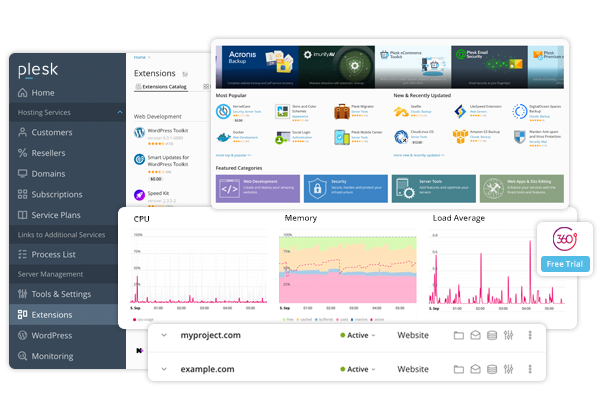Advanced Plesk Control Panel Tips & Features

Unleash the full potential of your web operations with these advanced Plesk Control Panel tips. Master Plesk management for optimized site performance.
Plesk Control Panel: Tips for Advanced Users
In this article, we delve into some advanced tips for using the Plesk Control Panel, providing actionable insights that can help optimize your website management processes and elevate your digital strategy.

Before diving into specific tips, it's crucial to understand the array of features Plesk offers. Known for its flexibility and scalability, Plesk supports various operating systems and integrates seamlessly with numerous applications, making it an ideal choice for professionals seeking to streamline their web operations.
Operating System Compatibility
Plesk's compatibility with multiple operating systems is a key advantage. This flexibility allows users to operate in environments they are most comfortable with, whether it's Windows or Linux. Understanding the nuances of each OS in relation to Plesk can help tailor the control panel to meet specific needs.
- Windows Integration: Full support for Microsoft technologies like ASP.NET and MSSQL, ideal for Windows-based infrastructures.
- Linux Support: Enhanced security and performance features tailored for Linux systems.
- Cross-Platform Management: Seamless management across different server environments.
Application Integration
Plesk's ability to integrate with a wide variety of applications enhances its utility for advanced users. This feature allows for a cohesive digital strategy by connecting essential tools and platforms directly to the control panel.
- CMS Integration: Native support for WordPress, Joomla, and Drupal for easy theme, plugin, and update management.
- E-commerce Platforms: Integration with Magento and WooCommerce for streamlined store, inventory, and order management.
- Developer Tools: Support for Git and Docker, enabling effortless code deployment and repository management.
Enhanced Security Protocols
Security is paramount in managing websites, and Plesk offers advanced protocols to safeguard your digital assets. Utilize Plesk's robust settings to protect your server and sites from threats.
- Fail2Ban: Automatically bans malicious IPs; customize rules for enhanced protection.
- SSL/TLS Certificates: Simplify certificate management with Let’s Encrypt for automated renewal.
- Firewall Configuration: Tailor rules to allow only trusted traffic and regularly audit for vulnerabilities.
User Management and Permissions
Effective user and permission management is crucial for security and efficiency. Plesk provides tools to control access and maintain integrity.
- Role-Based Access Control: Assign roles to limit feature access based on task requirements.
- Custom Permissions: Fine-tune what each user can see and do.
- Activity Monitoring: Review logs regularly to detect unauthorized actions.
Efficient Resource Management
For small business owners and freelancers, efficient resource allocation is critical. Plesk's tools enable you to monitor and optimize hosting performance.
Resource Usage Dashboard
The dashboard offers real-time CPU, memory, and disk monitoring, historical trend analysis, and alert configuration to prevent performance issues.
- Real-Time Monitoring: Identify resource-intensive processes immediately.
- Historical Data Analysis: Plan future needs and avoid downtime.
- Alerts: Configure notifications for critical usage levels.
Scheduled Resource Allocation
Schedule resource adjustments for peak and off-peak periods to maintain speed and save costs. Automate based on predefined criteria for seamless management.
- Peak Time Management: Allocate extra resources during high traffic.
- Resource Deallocation: Reduce resources during lulls.
- Automated Adjustment: Streamline based on usage thresholds.
Performance Optimization Techniques
Enhance server performance with load balancing, regular maintenance, and built-in monitoring tools to improve load times and reliability.
- Load Balancing: Distribute traffic across servers to prevent overload.
- Server Optimization: Update software and remove unnecessary files.
- Monitoring Tools: Gain insights to identify improvement areas.
Streamlining Website Management
Advanced users can leverage Plesk to save time and reduce complexity.
Automated Backups
Schedule incremental and full backups to ensure data safety, using local, FTP, or cloud storage as needed.
- Incremental Backups: Save time and storage by backing up only changes.
- Full Backups: Regularly scheduled for comprehensive protection.
- Storage Options: Choose local, FTP, or cloud solutions for accessibility.
Staging Environments
Test changes safely before going live. Clone, sync, and use version control to minimize downtime and track revisions.
- Clone & Sync: Replicate and synchronize updates seamlessly.
- Version Control: Track and revert changes as needed.
- Testing Protocols: Ensure thorough testing before deployment.
Content Management Simplification
Simplify maintenance with bulk updates, integrated SEO tools, and scheduled publishing directly from Plesk.
- Bulk Updates: Manage multiple sites and pages at once.
- SEO Management: Optimize content for search engines within Plesk.
- Content Scheduling: Plan and publish updates in advance.
Optimizing Plesk for Better Performance

Apply caching, compression, and database tuning strategies to improve load times and user experience.
- NGINX Caching: Store page copies to reduce load and speed delivery.
- Gzip Compression: Reduce asset sizes for faster downloads.
- CDN Integration: Distribute content globally for lower latency.
- Database Repair & Optimization: Maintain smooth database performance.
- Scheduled Backups: Automate regular database backups.
- Query Optimization: Analyze and improve slow queries.
- PHP Tuning: Adjust memory limits and execution times.
- Resource Allocation: Continuously monitor and adjust as needed.
- Security Measures: Mitigate attacks that impact performance.
Customizing the Plesk Environment
Tailor the panel to your workflow with dashboard layouts, themes, widgets, extensions, and custom scripts.
- Custom Dashboards: Prioritize the tools and info you use most.
- Themes: Match the interface to your branding.
- Widgets: Add functionality directly to your dashboard.
- SEO Toolkit: Analyze and improve search performance in Plesk.
- WordPress Toolkit: Mass update, clone, and secure WP sites.
- Backup Extensions: Explore real-time and advanced storage options.
- Script Automation: Automate repetitive tasks with custom scripts.
- API Integration: Connect Plesk to external services via scripts.
Script Management: Organize and secure your custom scripts.
Conclusion
Mastering Plesk’s advanced features enhances your website management, performance, and security. Continuous learning, customization, and staying updated will help you maintain a competitive edge and achieve your business goals.
Never Lose Traffic: Your 101 Guide to HTTPS Redirects
Related articles:

